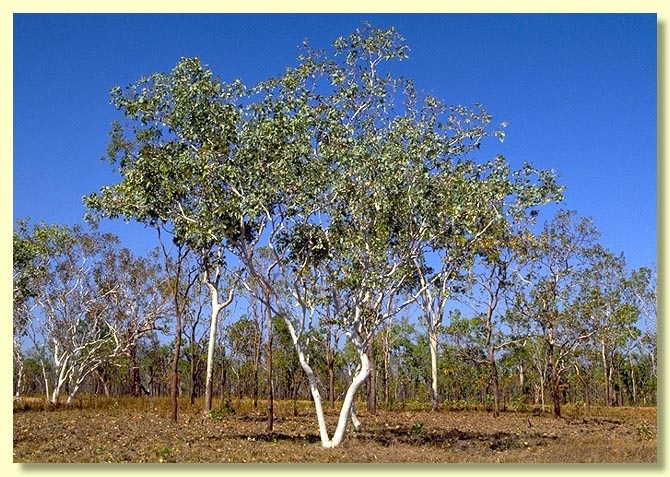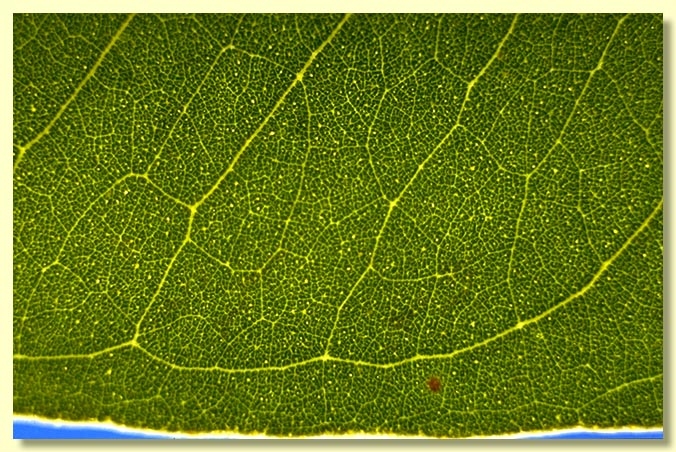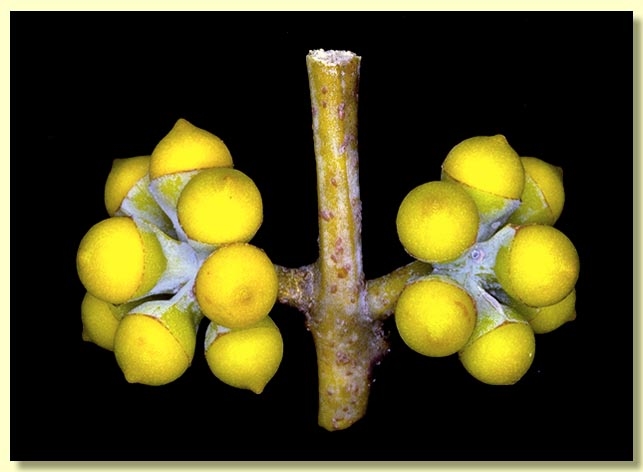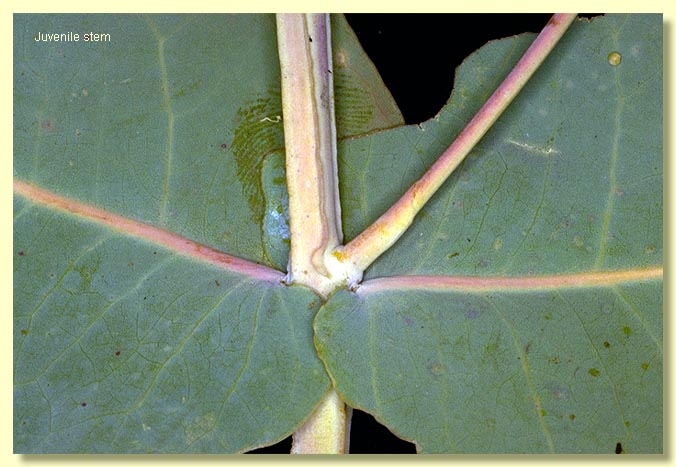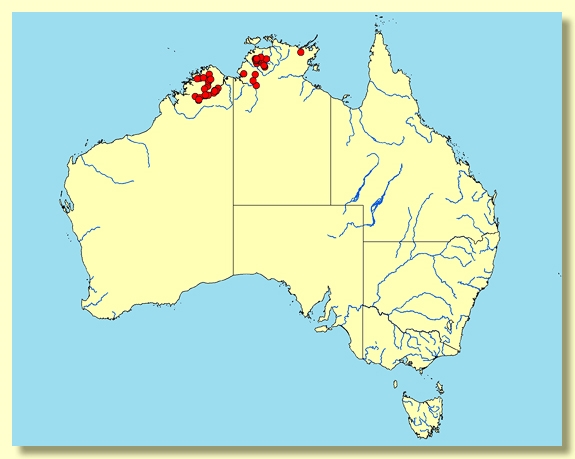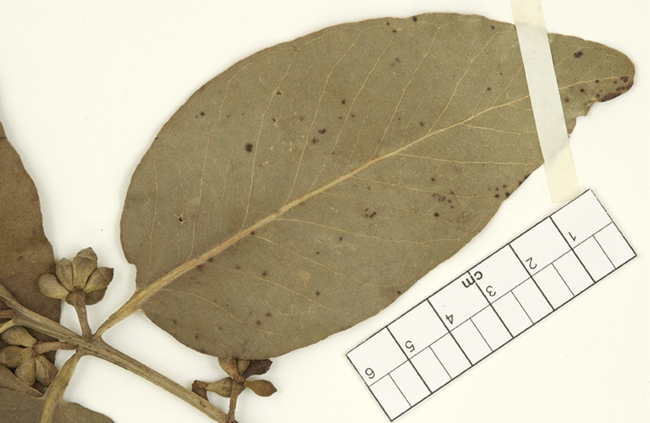Euclid - Online edition
Eucalyptus apodophylla
Eucalyptus | Symphyomyrtus | Exsertaria | Subexsertae | Applanatae
Small to medium-sized tree to ca 20 m tall. Forming a lignotuber. Crown partly deciduous in the mid to late dry season.
Bark smooth and very powdery throughout, new bark pale pink to pale yellow, maturing to white and sometimes weathering to grey just before decortication. Branchlets very glaucous.
Juvenile growth (coppice or field seedlings to 50 cm): stems square in cross-section and prominently winged on the longitudinal edges, glaucous; juvenile leaves sessile, opposite, ovate to elliptical, 7–15 cm long, 4–9 cm wide, base amplexicaul, glaucous, apex broad and blunt or shallowly notched.
Mature crown leaves opposite, sessile, rarely shortly petiolate on few to most of conopy leaves, petioles 0-0.8 cm long; blade broadly lanceolate to elliptical to ovate, 7–20 cm long, (3)3.6–9 cm wide, base amplexicaul to occasionally rounded, margin entire, apex pointed, occasionally rounded, usually discolorous, occasionally concolorous, dull blue-green to grey-green to glaucous, side-veins at a wider angle than 45° to the midrib, reticulation very dense, intramarginal vein present, oil glands small and intersectional or island.
Inflorescence axillary unbranched, peduncles 0.4–0.8 cm long, buds per umbel 7, sessile to shortly pedicellate (pedicels 0–0.3 cm long). Mature buds obovoid to globular, 0.3–0.7 cm long, 0.3–0.55 cm wide, glaucous, scar present, operculum rounded and shortly apiculate, hypanthium sometimes with two longitudinal ridges, stamens regularly inflexed, anthers oblong, versatile, dorsifixed, dehiscing by longitudinal slits, style long and straight, stigma blunt, locules 3 or 4, the placentae each with 6 or more vertical rows of ovules. Flowers white.
Fruit shortly pedicellate (pedicels 0.1–0.2 cm wide), obconical to hemispherical, glaucous but this white wax weathering with age, 0.3–0.5 cm long, 0.4–0.6(0.8) cm wide, disc raised and annular, valves 3 or 4, exserted.
Seeds brown, 1–1.7 mm long, ± flattened ovoid, dorsal surface shallowly reticulate, edge of seed sharply toothed or scarcely so, hilum ventral.
Cultivated seedlings (measured at ca node 10): cotyledons oblong-reniform, stem square in cross-section, glaucous; leaves opposite, sessile, ovate to elliptical, 4–7 cm long, 2.7–4.7 cm wide, base amplexicaul, apex rounded, glaucous.
Flowering has been recorded in July, August and September.
A small to medium-sized tree, usually growing in heavy soils on seasonally flooded, low lying areas or swamps of the western part of the Top End of the Northern Territory and the central and northern Kimberley region of Western Australia. (There is, however, one collection from the Arafura Swamp, Arnhem Land, in the eastern part of the Top End.) Characterised by the smooth white usually powdery bark, the broadly lanceolate to elliptical to ovate, opposite, sessile to shortly petiolate, discolorous, glaucous mature crown leaves.
Eucalyptus apodophylla belongs to a small group of species closely related to the red gums. This group is distinguished by having smooth powdery bark, adult leaves with dense to very dense venation and intersectional or absent oil glands, buds with inflexed stamens, fruit with an annular disc and ± flattened, toothed seeds with a ventral hilum. Other members of this group are E. bigalerita, E. platyphylla, E. tintinnans, E. alba and E. houseana.
Within this group, E. apodophylla is easily distinguished by its opposite, sessile to shortly petiolate, usually discolorous mature crown leaves. The other species mentioned all have mature crown leaves that are distinctly petiolate and concolorous.
Within its area of occurrence, E. apodophylla may be confused with other related white gums, i.e. E.brevifolia, E. confluens, E. cupularis, E. herbertiana, E. mooreana, E. ordiana, E. pantoleuca, E. rupestris and E. umbrawarrensis.
Eucalyptus brevifolia, E. confluens, E. cupularis, E. glomericassis, E. herbertiana, E. rupestris and E. umbrawarrensis all have alternate, petiolate mature crown leaves, usually narrower than 3 cm (E. apodophylla normally with mature crown leaves opposite, sessile and wider than 3.5 cm). E. ordiana and E. pantoleuca are distinguished by having distinctly petiolate mature crown leaves and E. pantoleuca is further distinguished by having 3-budded umbels (E. apodophylla with sessile to shortly petiolate mature crown leaves and seven-budded umbels). Both E. apodophylla and E. mooreana have opposite, sessile, glaucous leaves in the mature crown. These two can be distinguished on their bud shape. E. apodophylla has globular to obovoid buds with a round operculum, while E. mooreana has broadly fusiform buds with an acute operculum and occurs only on high steep rocky hillsides.
In 1994 Brooker & Kleinig in their "Field Guide to the Eucalypts vol. 3" described Eucalyptus apodophylla subsp. provecta distinguished from the common form of E. apodophylla by having shortly petiolate, non-glaucous crown leaves. From the collections in the Australian National Herbarium and limited field observations it seems to be scattered through that part of the Kimberley region from near Theda station in the north to the Beverley Springs area in the south. Typical E. apodophylla subsp. apodophylla also occurs in this area, and in EUCLID the two are not separated.
MORE ABOUT RED GUMS AND OTHER ASSOCIATED GROUPS
Eucalyptus apodophylla: Greek a- without; podos foot; phyllon leaf, most likely referring to the lack of a petiole at the base of the leaf.

